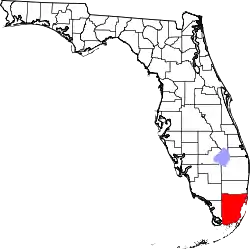North Miami Beach, Florida
North Miami Beach (commonly referred to as NMB) is a city in Miami-Dade County, Florida, United States. Originally named Fulford-by-the-Sea in 1926 after Captain William H. Fulford of the United States Coast Guard, the city was renamed North Miami Beach in 1931. The population was 41,523 at the 2010 census.
City of North Miami Beach
[1] | |
|---|---|
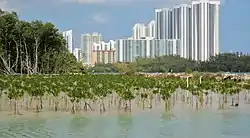 | |
.png.webp) Seal | |
| Nickname(s): NMB | |
| Motto(s): "Where People Care" | |
 Location in Miami-Dade County and the state of Florida | |
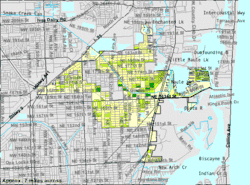 U.S. Census Bureau map showing city limits | |
| Coordinates: 25°55′49″N 80°10′11″W | |
| Country | |
| State | |
| County | |
| Incorporated | June 15, 1931 |
| Government | |
| • Type | Commission-Manager |
| • Mayor | Anthony F. DeFillipo |
| • City Commissioners | Paule Villard, Phyllis S. Smith, Fortuna Smukler, McKenzie Fleurimond, Barbara Kramer and Michael Joseph |
| • City Manager | Esmond K. Scott |
| • City Clerk | Andrise Bernard |
| Area | |
| • City | 5.37 sq mi (13.91 km2) |
| • Land | 4.85 sq mi (12.55 km2) |
| • Water | 0.53 sq mi (1.36 km2) 6.43% |
| Elevation | 10 ft (3 m) |
| Population (2010) | |
| • City | 41,523 |
| • Estimate (2019)[4] | 43,041 |
| • Density | 8,881.76/sq mi (3,429.14/km2) |
| • Metro | 5,422,200 |
| Time zone | UTC-5 (EST) |
| • Summer (DST) | UTC-4 (EDT) |
| Zip Codes | 33160,33162,33169, 33179,33180,33181 |
| Area code(s) | 305, 786 |
| FIPS code | 12-49475[5] |
| GNIS feature ID | 0287838[6] |
| Website | http://www.citynmb.com |
The hurricane of 1926 essentially ended the South Florida real estate boom, and in an effort to alleviate their losses and the damage to the city, local residents came together as the Town of Fulford. In 1927, the city was incorporated as the City of Fulford.[7]
Geography
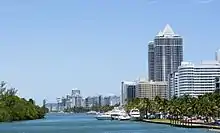
North Miami Beach is located at 25°55′49″N 80°10′1″W.[8] According to the United States Census Bureau, the city has a total area of 5.3 square miles (14 km2). 5.0 square miles (13 km2) of it is land and 0.3 square miles (0.78 km2) of it (6.43%) is water.
Although the North Miami Beach boundaries once stretched to the Atlantic Ocean, this city on the Intracoastal Waterway no longer has any beaches within its city limits, although they are a short distance away across the inlet.
Surrounding areas
Demographics
| Historical population | |||
|---|---|---|---|
| Census | Pop. | %± | |
| 1940 | 871 | — | |
| 1950 | 2,129 | 144.4% | |
| 1960 | 21,405 | 905.4% | |
| 1970 | 30,544 | 42.7% | |
| 1980 | 36,553 | 19.7% | |
| 1990 | 35,359 | −3.3% | |
| 2000 | 40,786 | 15.3% | |
| 2010 | 41,523 | 1.8% | |
| 2019 (est.) | 43,041 | [4] | 3.7% |
| U.S. Decennial Census[9] | |||
As of 2010, there were 16,402 households, out of which 12.1% were vacant. As of 2000, 37.6% had children under the age of 18 living with them. 44.3% were married couples living together, 19.5% had a female householder with no husband present, and 29.9% were non-families. 23.9% of all households were made up of individuals, and 8.6% had someone living alone who was 65 years of age or older. The average household size was 2.89 and the average family size was 3.44.
In 2000, the city population was spread out, with 27.3% under the age of 18, 9.4% from 18 to 24, 30.9% from 25 to 44, 21.1% from 45 to 64, and 11.3% who were 65 years of age or older. The median age was 34 years. For every 100 females, there were 91.6 males. For every 100 females age 18 and over, there were 86.3 males.
In 2000, the median income for a household in the city was $31,377, and the median income for a family was $35,047. Males had a median income of $26,278 versus $22,110 for females. The per capita income for the city was $14,699. About 18.4% of families and 20.5% of the population were below the poverty line, including 25.1% of those under age 18 and 18.2% of those age 65 or over.
As of 2000, English was the first language for 38.50% of all residents, while Spanish accounted for 31.97%. French Creole was 19.32%, French made up 2.33%, Chinese (which included Cantonese) was totaled at 1.66%, Portuguese totaled 1.20%, Hebrew was at 0.87%, Russian at 0.65%, Yiddish spoken by 0.56%, and Italian was the mother tongue for 0.52% of the population.[10]
As of 2000, North Miami Beach had the fifth highest percentage of Haitian residents in the U.S., with 19.90% of the U.S. populace.[11] It had the 48th highest percentage of Colombian residents in the U.S., at 2.83% of the city's population,[12] and the 68th highest percentage of Cuban residents in the US, at 4.92% of the city's population.[13] It also had the 62nd highest percentage of Dominicans in the U.S., at 2.39%,[14] while it had the ninth highest percentage of Bahamians at 1.10% of all residents.[15] North Miami Beach's Jamaican community had the 28th highest percentage of residents, which was at 5.50% of all residents.[11] It is also home to the thirtieth highest percentage of Peruvian residents in the U.S., at 1.80% of the population.[16]
North Miami Beach has a large middle class Haitian-American and Jewish-American community who were born in the U.S. or abroad.
Despite making up only 3.4% of North Miami Beaches population. The cities main commercial artery along NE 167th street converging into North Miami Beach Boulevard and then becoming 163rd street. Has taken the unofficial name of "Chinatown" due to the large concentration of Asian ran and operated businesses in the area. The area has been referred to unofficially as "Chinatown" since the early 1990s by both locals and North Miami Beach city officials. As of recent even Miami-Dade County officials have even begun to reference the area as Chinatown. Even local guides and Miami websites have called 163rd street Miami's unofficial Chinatown.
| North Miami Beach demographics | |||
|---|---|---|---|
| 2010 Census | North Miami Beach | Miami-Dade County | Florida |
| Total population | 41,523 | 2,496,435 | 18,801,310 |
| Population, percent change, 2000 to 2010 | +1.8%% | +10.8% | +17.6% |
| Population density | 8,602.2/sq mi | 1,315.5/sq mi | 350.6/sq mi |
| White or Caucasian (including White Hispanic) | 47.1% | 73.8% | 75.0% |
| (Non-Hispanic White or Caucasian) | 18.4% | 15.4% | 57.9% |
| Black or African-American | 41.4% | 18.9% | 16.0% |
| Hispanic or Latino (of any race) | 36.6% | 65.0% | 22.5% |
| Asian | 3.4% | 1.5% | 2.4% |
| Native American or Native Alaskan | 0.2% | 0.2% | 0.4% |
| Pacific Islander or Native Hawaiian | 0.1% | 0.0% | 0.1% |
| Two or more races (multiracial) | 3.8% | 2.4% | 2.5% |
| Some other race | 4.0% | 3.2% | 3.6% |
Attractions
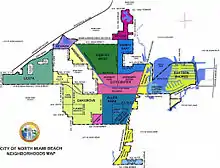

Attractions in the vicinity of North Miami Beach include a line of popular Atlantic Ocean beaches, Ancient Spanish Monastery, Oleta River State Park, Greynolds Park, East Greynolds Park, Fulford-by-the-Sea Monument, and Aventura Mall.
North Miami Beach's has a historic 12th century Medieval Spanish monastery, the St. Bernard de Clairvaux Church. This stone building around a patio, the cloisters of the Monastery of St. Bernard de Clairvaux, was built in Sacramenia, Segovia, Spain in the 12th century. It was purchased by William Randolph Hearst in the 1920s, dismantled and shipped to the United States, and reassembled after Hearst's death in North Miami Beach in the 1950s. It is a tourism attraction and a popular spot for weddings.
Parks and recreation
In 1966, a major accomplishment was the completion of the tennis complex and two community centers, Victory Park and Uleta Community Center.
In 1968, the Washington Park Community Center[17] was built, and the Allen Park Youth Center[18] was completed in 1973.
North Miami Beach expanded its parks in the 1980s as a result of the city commission making strides to benefit the community.
The city now has the Judge Arthur I. Snyder Tennis Center. It includes twelve lighted clay Hydrogrid tennis courts, six lighted lay-kold hard tennis courts, four racquetball courts, and two paddleball courts. The center also has a clubhouse and pro-shop, a picnic area, and lounge and shower facilities.[19]
Government and infrastructure
North Miami Beach is governed by a commission-manager system[20] in the form of a Mayor, Commission, and a professional City Manager. In this type of a government, commission members are the leaders and policy makers in the community. This form of government was implemented in 1958, after a new charter was voted on.[7]
The mayor is elected citywide and serves up to two consecutive two-year terms.[21]
There is an elected mayor and six-member city commission, with the city manager, city clerk, and city attorney being appointed positions that are responsible for implementing the policies of the city commission.[21]
The Federal Bureau of Investigation (FBI) Miami field office was previously in North Miami Beach. It moved to Miramar on December 8, 2014.[22]
In 1993, in an effort to promote neighborhood stability throughout the city, North Miami Beach built a state-of-the-art police station and redeveloped infrastructure in the Government Center neighborhood.
The bond program Proud Neighborhoods took place in September 2000 and had 67 different projects. This allowed for the improvement of streets, sidewalks, lighting and landscaping in every neighborhood of the city. It took five years but it brought substantial improvements.
Education
Primary and secondary schools
Dade County Public Schools serves North Miami Beach.
Public elementary schools
- Fulford Elementary School
- Greynolds Park Elementary School
- Madie Ives Elementary School
- Oak Grove Elementary School
- Ojus Elementary School
- Sabal Palm Elementary
Public middle schools
- Highland Oaks Middle School
- John F. Kennedy Middle School
Public high schools
- Alonzo and Tracy Mourning Senior High Biscayne Bay Campus
- Dr. Michael Krop Senior High School
- North Miami Beach Senior High School
Prior to the opening of North Miami Beach High and Krop, students from North Miami Beach were assigned to Miami Beach High School and Miami Norland High School.[23]
Colleges and universities
- Nova Southeastern University – Miami Campus
- Union Institute and University – North Miami Beach campus
Public libraries
North Miami Beach Public Library (NMB Library), also referred to as the Lafe Allen Public Library, is a 23,000 square foot facility located at 1601 NE 164th Street in North Miami Beach, Florida. The library's collection currently contains over 60,000 items, including both fiction and non-fiction materials, DVDs, audio books, compact discs, newspapers, magazines, and foreign language materials. Digital services include access to e-materials and reference resources, such as Florida Electronic Library, Newsbank, Reference USA, World Book, NoveList Plus, and more.[24]
In 1959, The North Miami Beach Library was initially opened inside of a storefront on NE 163rd Street as a branch of the Miami-Dade Public Library System (then known as the City of Miami Library system). This location was relocated and expanded to two storefronts at the corner of NE 19th Avenue and NE 169th Street the following year.[25] In 1961, however, the city ended its attachment with the City of Miami Library system and became an independent library. After residents of the City of North Miami Beach voted to build a permanent location for the library in 1964, a new building was constructed on 164th Street and opened in 1965. Renovations to this facility in 1981 and 1994 grew the branch from its original 10,000 square feet to make room for the library's expanding collection.
The NMB Library offers a variety of services to the residents of North Miami Beach, such as access to study and meeting rooms, employment resources, early literacy programs, voter registration forms, citizenship materials, and passport assistance. Computers, printers, copiers, scanners, and fax machine services are also available. The library's dedicated teen area, known as the Discovery District, is a space specifically designed to provide library patrons aged 13–19 with a place to read, study, or work on school projects.[26] Access to computers, 3D printers, virtual reality, and zSpace for educational and recreational purposes is also provided.
Notable people
- Garcelle Beauvais
- Andrea Bocelli
- Johnathan Cyprien (born 1990), NFL safety
- Louis Delmas
- Paul Gleason
- Max Jean-Gilles
- Larry Kahn (born 1953/1954), tiddlywinks player
- MC Jin
- Cheryl Patton (born 1949), Miss Florida USA 1967, Miss USA 1967
- Sheryl Sandberg
- Jonathan Zaslow
- Marlins Man
- Brad Meltzer
References
- "Article I. Incorporation and Boundaries". City of North Miami Beach. Archived from the original on 18 November 2012. Retrieved 9 December 2012.
- "Article I. Incorporation and Boundaries". City of North Miami Beach. Archived from the original on 18 November 2012. Retrieved 9 December 2012.
- "2019 U.S. Gazetteer Files". United States Census Bureau. Retrieved July 2, 2020.
- "Population and Housing Unit Estimates". United States Census Bureau. May 24, 2020. Retrieved May 27, 2020.
- "U.S. Census website". United States Census Bureau. Retrieved 2008-01-31.
- "US Board on Geographic Names". United States Geological Survey. 2007-10-25. Retrieved 2008-01-31.
- "Our History – City of North Miami Beach, Florida". www.citynmb.com. Retrieved 2016-04-18.
- "US Gazetteer files: 2010, 2000, and 1990". United States Census Bureau. 2011-02-12. Retrieved 2011-04-23.
- "Census of Population and Housing". Census.gov. Retrieved June 4, 2015.
- "MLA Data Center Results of North Miami Beach, FL". Modern Language Association. Retrieved 2007-10-28.
- "Ancestry Map of Haitian Communities". Epodunk.com. Archived from the original on 2012-12-11. Retrieved 2007-10-28.
- "Ancestry Map of Colombian Communities". Epodunk.com. Retrieved 2007-10-28.
- "Ancestry Map of Cuban Communities". Epodunk.com. Retrieved 2007-10-28.
- "Ancestry Map of Dominican Communities". Epodunk.com. Archived from the original on 2010-10-17. Retrieved 2007-10-28.
- "Ancestry Map of Bahamian Communities". Epodunk.com. Retrieved 2007-10-28.
- "Ancestry Map of Peruvian Communities". Epodunk.com. Archived from the original on 2007-10-11. Retrieved 2007-10-28.
- Washington Park Community Center
- Allen Park Youth Center
- "Judge Arthur I. Snyder Tennis Center." City of North Miami Beach. Retrieved on March 12, 2010.
- "GOVERNMENT | North Miami Beach, FL". www.citynmb.com. Retrieved 2019-03-09.
- "City of North Miami – Government". www.northmiamifl.gov. Retrieved 2016-04-18.
- "FBI Miami Division Moves to New Location." Federal Bureau of Investigation. December 8, 2014. Retrieved on June 9, 2015.
- Bramson, Seth. From Farms and Fields to the Future: The Incredible History of North Miami Beach. Arcadia Publishing, June 1, 2012. ISBN 1614236410, 9781614236412. Google Books PT 125. "[...] and then on to North Miami Beach Senior High,[...] or Dr. Michael Krop Senior High,[...] to complete their secondary educations. (Prior to the opening of NMB and Krop, North Miami Beach's high school-age students went to North Miami or Norland High Schools.)"
- "About Us". North Miami Beach Public Library. Retrieved 19 April 2020.
- "The History of NMB Library". City of North Miami Beach. Retrieved 19 April 2020.
- "Discovery District". North Miami Beach Public Library. Retrieved 19 April 2020.
External links
| Wikimedia Commons has media related to North Miami Beach, Florida. |
